Pre-Algebra Mathematics Folio: Concept, Levels, Resources & Rationale
VerifiedAdded on 2023/06/12
|9
|2695
|75
Practical Assignment
AI Summary
This pre-algebra mathematics folio delves into the core concepts of pre-algebra, focusing on its curriculum connections and how it progresses through different learning levels (one, two, and three). It highlights content descriptors such as fractions, percentages, and negative numbers, providing examples and resources, including ICT tools, to aid understanding at each level. The folio also includes a rationale for the resource selection, supported by academic literature, and emphasizes the importance of interactive and technology-enhanced learning methodologies. The document concludes by reinforcing the significance of a strong mathematical foundation and the role of both teacher and student in achieving success in mathematics education. Desklib provides access to this and other student-contributed assignments.
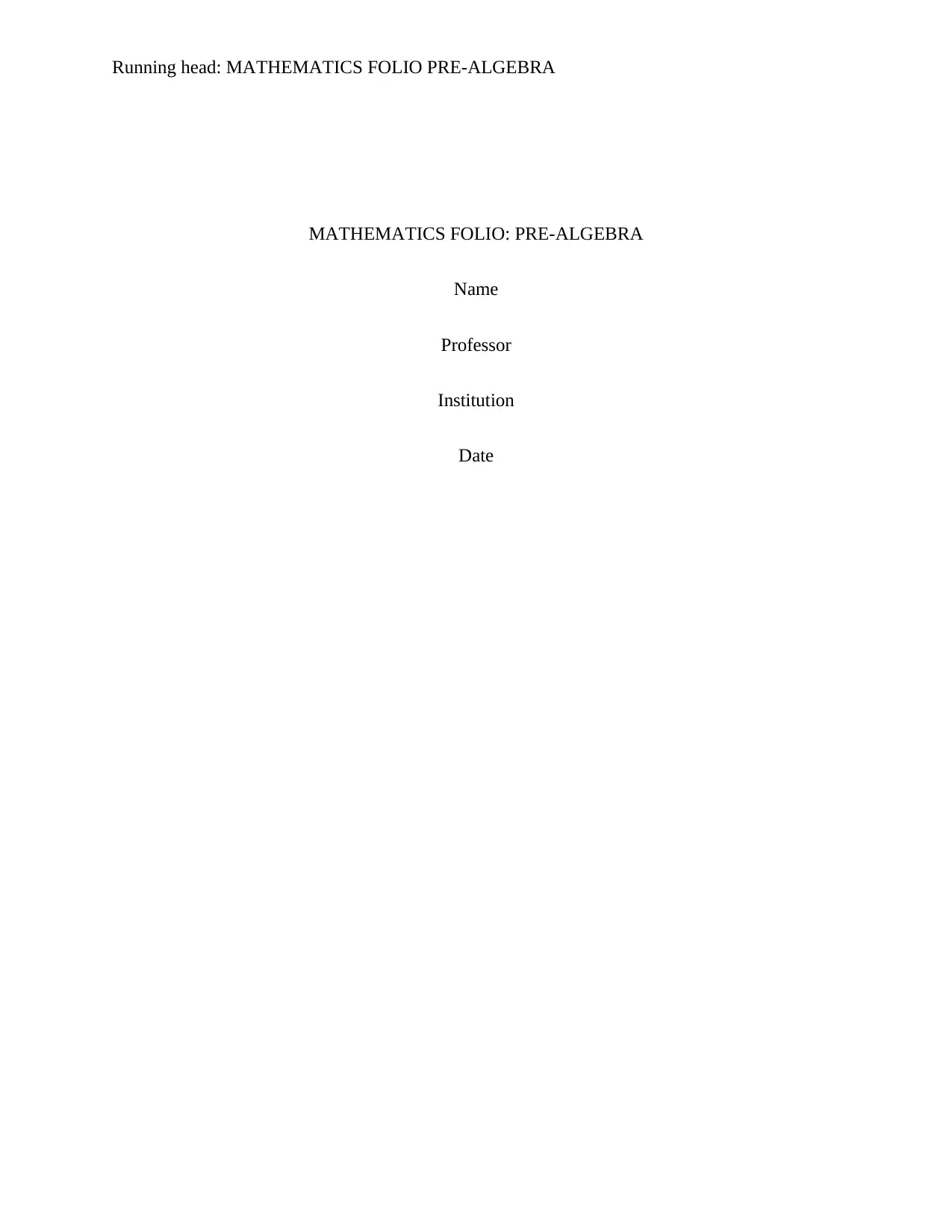
Running head: MATHEMATICS FOLIO PRE-ALGEBRA
MATHEMATICS FOLIO: PRE-ALGEBRA
Name
Professor
Institution
Date
MATHEMATICS FOLIO: PRE-ALGEBRA
Name
Professor
Institution
Date
Paraphrase This Document
Need a fresh take? Get an instant paraphrase of this document with our AI Paraphraser
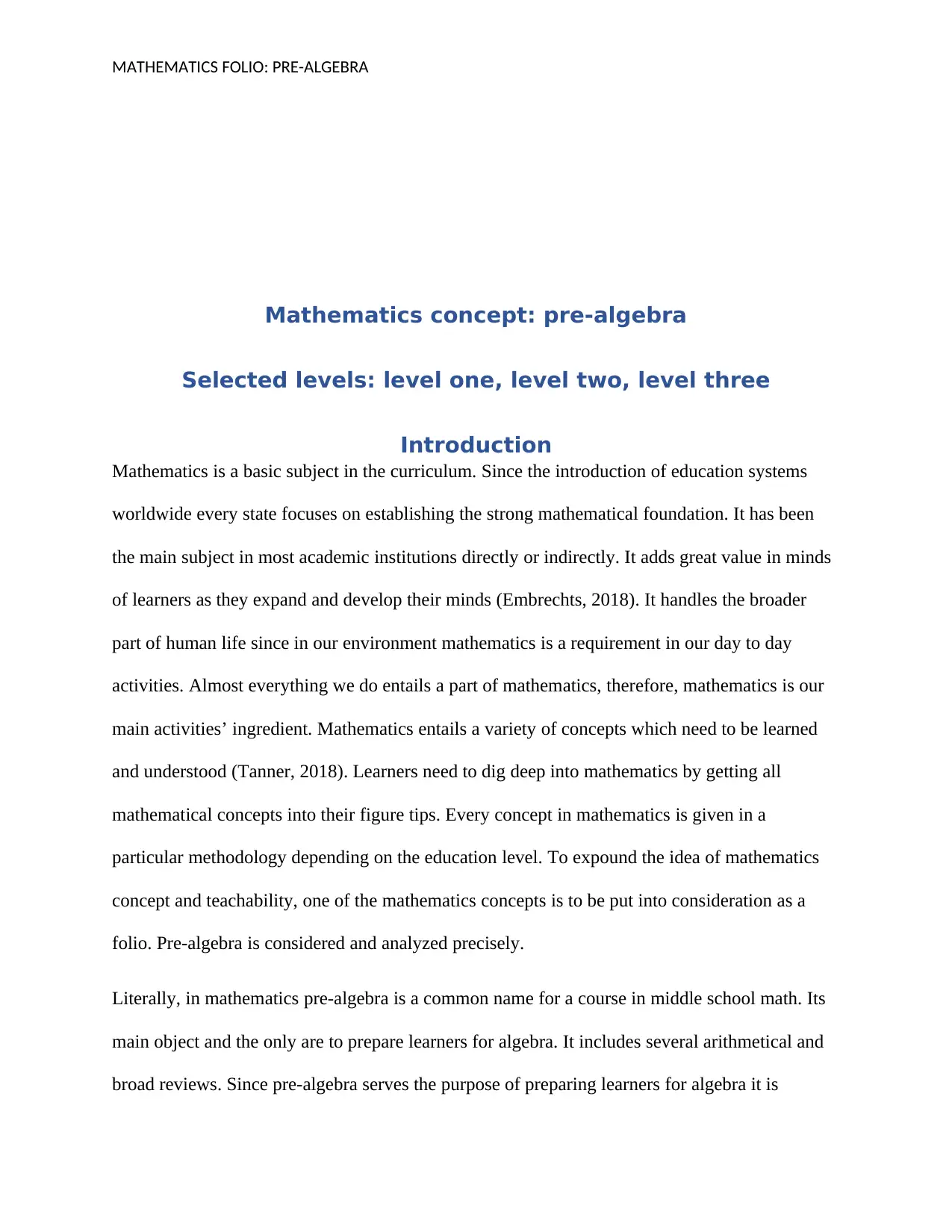
MATHEMATICS FOLIO: PRE-ALGEBRA
Mathematics concept: pre-algebra
Selected levels: level one, level two, level three
Introduction
Mathematics is a basic subject in the curriculum. Since the introduction of education systems
worldwide every state focuses on establishing the strong mathematical foundation. It has been
the main subject in most academic institutions directly or indirectly. It adds great value in minds
of learners as they expand and develop their minds (Embrechts, 2018). It handles the broader
part of human life since in our environment mathematics is a requirement in our day to day
activities. Almost everything we do entails a part of mathematics, therefore, mathematics is our
main activities’ ingredient. Mathematics entails a variety of concepts which need to be learned
and understood (Tanner, 2018). Learners need to dig deep into mathematics by getting all
mathematical concepts into their figure tips. Every concept in mathematics is given in a
particular methodology depending on the education level. To expound the idea of mathematics
concept and teachability, one of the mathematics concepts is to be put into consideration as a
folio. Pre-algebra is considered and analyzed precisely.
Literally, in mathematics pre-algebra is a common name for a course in middle school math. Its
main object and the only are to prepare learners for algebra. It includes several arithmetical and
broad reviews. Since pre-algebra serves the purpose of preparing learners for algebra it is
Mathematics concept: pre-algebra
Selected levels: level one, level two, level three
Introduction
Mathematics is a basic subject in the curriculum. Since the introduction of education systems
worldwide every state focuses on establishing the strong mathematical foundation. It has been
the main subject in most academic institutions directly or indirectly. It adds great value in minds
of learners as they expand and develop their minds (Embrechts, 2018). It handles the broader
part of human life since in our environment mathematics is a requirement in our day to day
activities. Almost everything we do entails a part of mathematics, therefore, mathematics is our
main activities’ ingredient. Mathematics entails a variety of concepts which need to be learned
and understood (Tanner, 2018). Learners need to dig deep into mathematics by getting all
mathematical concepts into their figure tips. Every concept in mathematics is given in a
particular methodology depending on the education level. To expound the idea of mathematics
concept and teachability, one of the mathematics concepts is to be put into consideration as a
folio. Pre-algebra is considered and analyzed precisely.
Literally, in mathematics pre-algebra is a common name for a course in middle school math. Its
main object and the only are to prepare learners for algebra. It includes several arithmetical and
broad reviews. Since pre-algebra serves the purpose of preparing learners for algebra it is
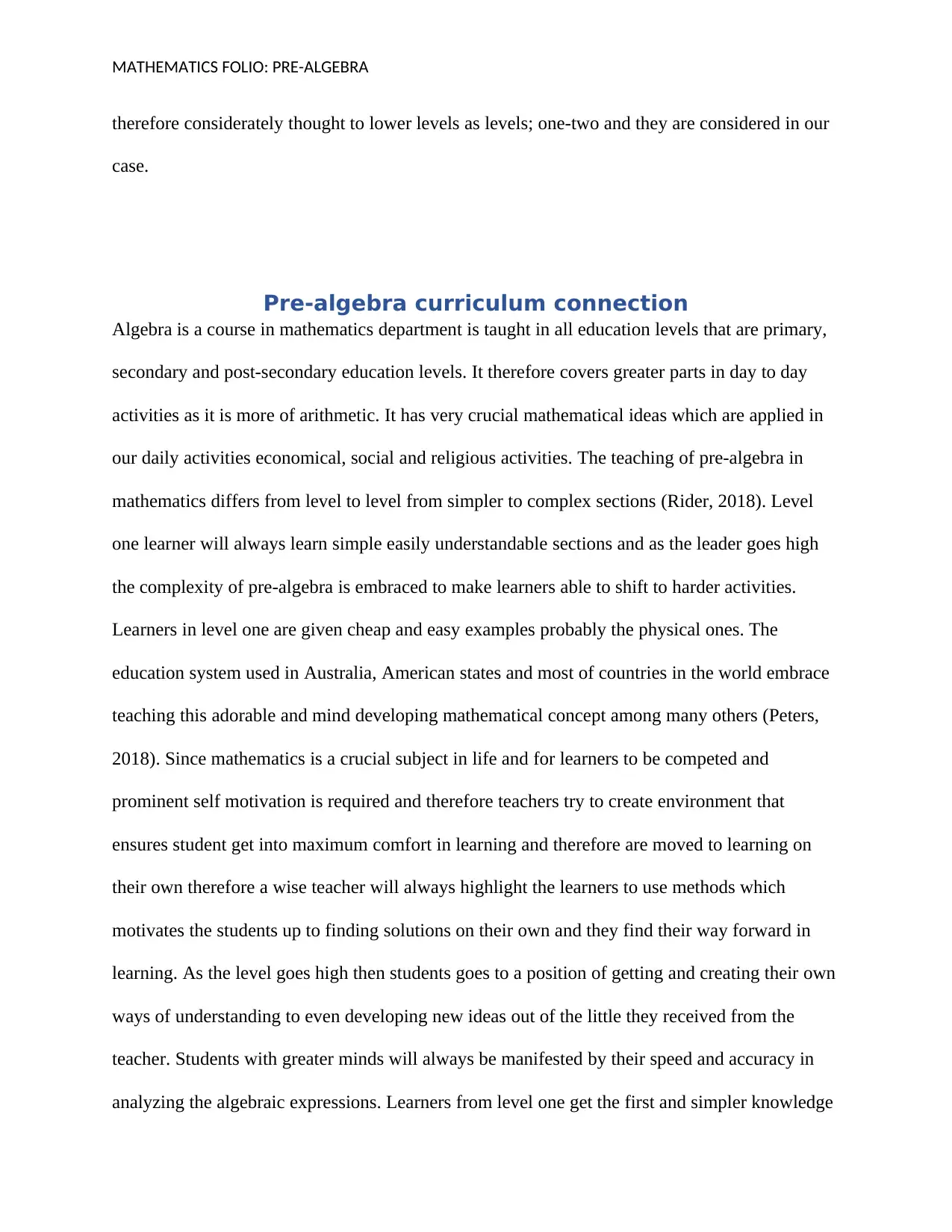
MATHEMATICS FOLIO: PRE-ALGEBRA
therefore considerately thought to lower levels as levels; one-two and they are considered in our
case.
Pre-algebra curriculum connection
Algebra is a course in mathematics department is taught in all education levels that are primary,
secondary and post-secondary education levels. It therefore covers greater parts in day to day
activities as it is more of arithmetic. It has very crucial mathematical ideas which are applied in
our daily activities economical, social and religious activities. The teaching of pre-algebra in
mathematics differs from level to level from simpler to complex sections (Rider, 2018). Level
one learner will always learn simple easily understandable sections and as the leader goes high
the complexity of pre-algebra is embraced to make learners able to shift to harder activities.
Learners in level one are given cheap and easy examples probably the physical ones. The
education system used in Australia, American states and most of countries in the world embrace
teaching this adorable and mind developing mathematical concept among many others (Peters,
2018). Since mathematics is a crucial subject in life and for learners to be competed and
prominent self motivation is required and therefore teachers try to create environment that
ensures student get into maximum comfort in learning and therefore are moved to learning on
their own therefore a wise teacher will always highlight the learners to use methods which
motivates the students up to finding solutions on their own and they find their way forward in
learning. As the level goes high then students goes to a position of getting and creating their own
ways of understanding to even developing new ideas out of the little they received from the
teacher. Students with greater minds will always be manifested by their speed and accuracy in
analyzing the algebraic expressions. Learners from level one get the first and simpler knowledge
therefore considerately thought to lower levels as levels; one-two and they are considered in our
case.
Pre-algebra curriculum connection
Algebra is a course in mathematics department is taught in all education levels that are primary,
secondary and post-secondary education levels. It therefore covers greater parts in day to day
activities as it is more of arithmetic. It has very crucial mathematical ideas which are applied in
our daily activities economical, social and religious activities. The teaching of pre-algebra in
mathematics differs from level to level from simpler to complex sections (Rider, 2018). Level
one learner will always learn simple easily understandable sections and as the leader goes high
the complexity of pre-algebra is embraced to make learners able to shift to harder activities.
Learners in level one are given cheap and easy examples probably the physical ones. The
education system used in Australia, American states and most of countries in the world embrace
teaching this adorable and mind developing mathematical concept among many others (Peters,
2018). Since mathematics is a crucial subject in life and for learners to be competed and
prominent self motivation is required and therefore teachers try to create environment that
ensures student get into maximum comfort in learning and therefore are moved to learning on
their own therefore a wise teacher will always highlight the learners to use methods which
motivates the students up to finding solutions on their own and they find their way forward in
learning. As the level goes high then students goes to a position of getting and creating their own
ways of understanding to even developing new ideas out of the little they received from the
teacher. Students with greater minds will always be manifested by their speed and accuracy in
analyzing the algebraic expressions. Learners from level one get the first and simpler knowledge
⊘ This is a preview!⊘
Do you want full access?
Subscribe today to unlock all pages.

Trusted by 1+ million students worldwide
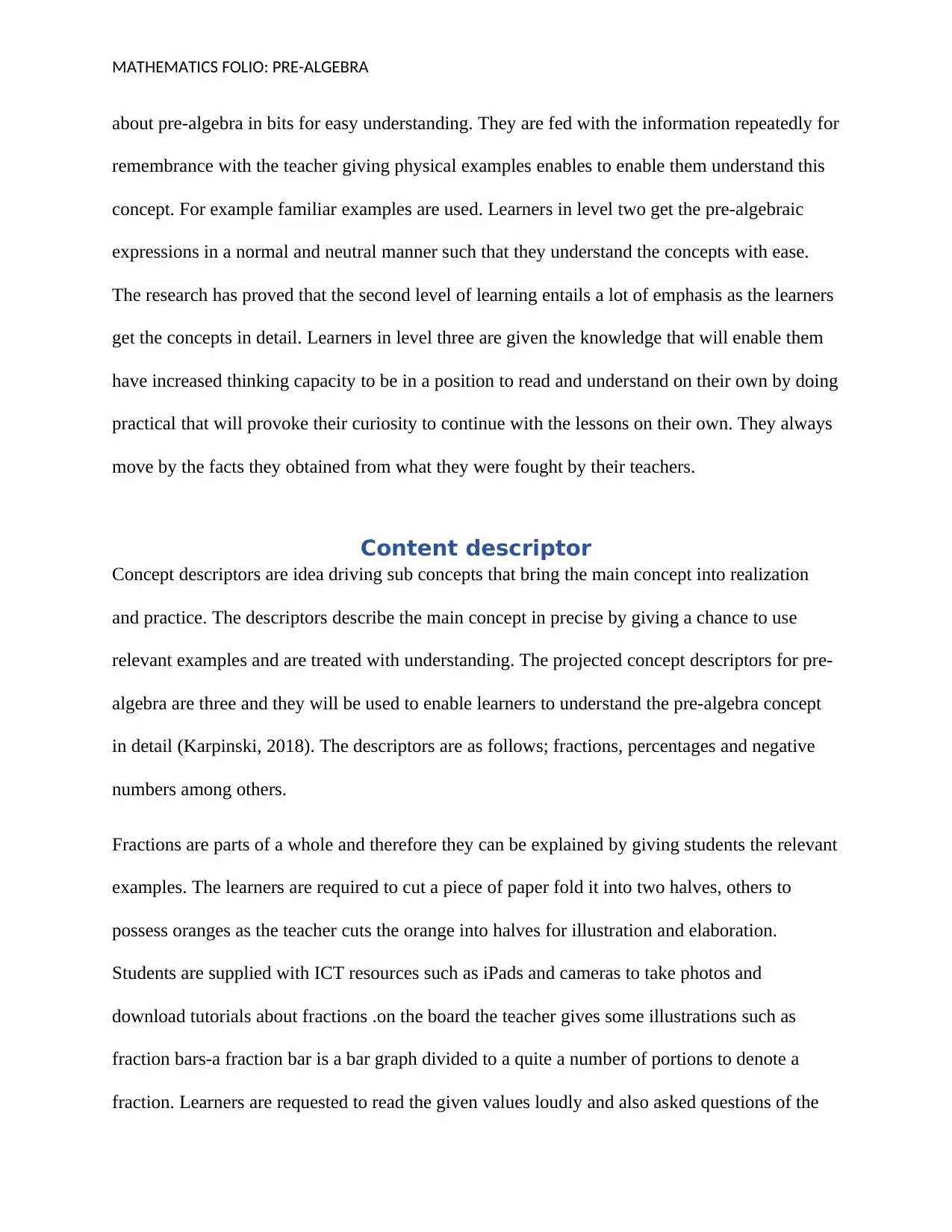
MATHEMATICS FOLIO: PRE-ALGEBRA
about pre-algebra in bits for easy understanding. They are fed with the information repeatedly for
remembrance with the teacher giving physical examples enables to enable them understand this
concept. For example familiar examples are used. Learners in level two get the pre-algebraic
expressions in a normal and neutral manner such that they understand the concepts with ease.
The research has proved that the second level of learning entails a lot of emphasis as the learners
get the concepts in detail. Learners in level three are given the knowledge that will enable them
have increased thinking capacity to be in a position to read and understand on their own by doing
practical that will provoke their curiosity to continue with the lessons on their own. They always
move by the facts they obtained from what they were fought by their teachers.
Content descriptor
Concept descriptors are idea driving sub concepts that bring the main concept into realization
and practice. The descriptors describe the main concept in precise by giving a chance to use
relevant examples and are treated with understanding. The projected concept descriptors for pre-
algebra are three and they will be used to enable learners to understand the pre-algebra concept
in detail (Karpinski, 2018). The descriptors are as follows; fractions, percentages and negative
numbers among others.
Fractions are parts of a whole and therefore they can be explained by giving students the relevant
examples. The learners are required to cut a piece of paper fold it into two halves, others to
possess oranges as the teacher cuts the orange into halves for illustration and elaboration.
Students are supplied with ICT resources such as iPads and cameras to take photos and
download tutorials about fractions .on the board the teacher gives some illustrations such as
fraction bars-a fraction bar is a bar graph divided to a quite a number of portions to denote a
fraction. Learners are requested to read the given values loudly and also asked questions of the
about pre-algebra in bits for easy understanding. They are fed with the information repeatedly for
remembrance with the teacher giving physical examples enables to enable them understand this
concept. For example familiar examples are used. Learners in level two get the pre-algebraic
expressions in a normal and neutral manner such that they understand the concepts with ease.
The research has proved that the second level of learning entails a lot of emphasis as the learners
get the concepts in detail. Learners in level three are given the knowledge that will enable them
have increased thinking capacity to be in a position to read and understand on their own by doing
practical that will provoke their curiosity to continue with the lessons on their own. They always
move by the facts they obtained from what they were fought by their teachers.
Content descriptor
Concept descriptors are idea driving sub concepts that bring the main concept into realization
and practice. The descriptors describe the main concept in precise by giving a chance to use
relevant examples and are treated with understanding. The projected concept descriptors for pre-
algebra are three and they will be used to enable learners to understand the pre-algebra concept
in detail (Karpinski, 2018). The descriptors are as follows; fractions, percentages and negative
numbers among others.
Fractions are parts of a whole and therefore they can be explained by giving students the relevant
examples. The learners are required to cut a piece of paper fold it into two halves, others to
possess oranges as the teacher cuts the orange into halves for illustration and elaboration.
Students are supplied with ICT resources such as iPads and cameras to take photos and
download tutorials about fractions .on the board the teacher gives some illustrations such as
fraction bars-a fraction bar is a bar graph divided to a quite a number of portions to denote a
fraction. Learners are requested to read the given values loudly and also asked questions of the
Paraphrase This Document
Need a fresh take? Get an instant paraphrase of this document with our AI Paraphraser
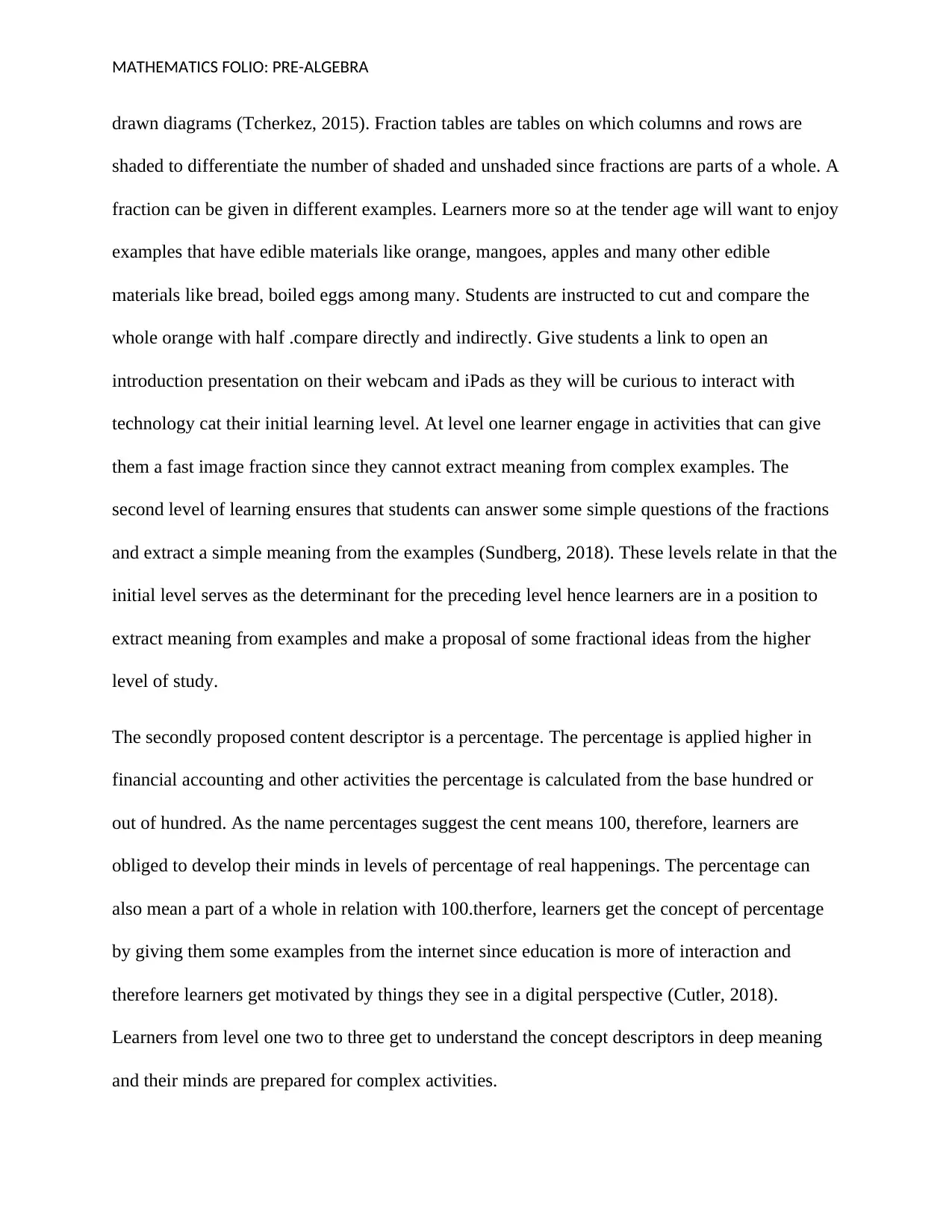
MATHEMATICS FOLIO: PRE-ALGEBRA
drawn diagrams (Tcherkez, 2015). Fraction tables are tables on which columns and rows are
shaded to differentiate the number of shaded and unshaded since fractions are parts of a whole. A
fraction can be given in different examples. Learners more so at the tender age will want to enjoy
examples that have edible materials like orange, mangoes, apples and many other edible
materials like bread, boiled eggs among many. Students are instructed to cut and compare the
whole orange with half .compare directly and indirectly. Give students a link to open an
introduction presentation on their webcam and iPads as they will be curious to interact with
technology cat their initial learning level. At level one learner engage in activities that can give
them a fast image fraction since they cannot extract meaning from complex examples. The
second level of learning ensures that students can answer some simple questions of the fractions
and extract a simple meaning from the examples (Sundberg, 2018). These levels relate in that the
initial level serves as the determinant for the preceding level hence learners are in a position to
extract meaning from examples and make a proposal of some fractional ideas from the higher
level of study.
The secondly proposed content descriptor is a percentage. The percentage is applied higher in
financial accounting and other activities the percentage is calculated from the base hundred or
out of hundred. As the name percentages suggest the cent means 100, therefore, learners are
obliged to develop their minds in levels of percentage of real happenings. The percentage can
also mean a part of a whole in relation with 100.therfore, learners get the concept of percentage
by giving them some examples from the internet since education is more of interaction and
therefore learners get motivated by things they see in a digital perspective (Cutler, 2018).
Learners from level one two to three get to understand the concept descriptors in deep meaning
and their minds are prepared for complex activities.
drawn diagrams (Tcherkez, 2015). Fraction tables are tables on which columns and rows are
shaded to differentiate the number of shaded and unshaded since fractions are parts of a whole. A
fraction can be given in different examples. Learners more so at the tender age will want to enjoy
examples that have edible materials like orange, mangoes, apples and many other edible
materials like bread, boiled eggs among many. Students are instructed to cut and compare the
whole orange with half .compare directly and indirectly. Give students a link to open an
introduction presentation on their webcam and iPads as they will be curious to interact with
technology cat their initial learning level. At level one learner engage in activities that can give
them a fast image fraction since they cannot extract meaning from complex examples. The
second level of learning ensures that students can answer some simple questions of the fractions
and extract a simple meaning from the examples (Sundberg, 2018). These levels relate in that the
initial level serves as the determinant for the preceding level hence learners are in a position to
extract meaning from examples and make a proposal of some fractional ideas from the higher
level of study.
The secondly proposed content descriptor is a percentage. The percentage is applied higher in
financial accounting and other activities the percentage is calculated from the base hundred or
out of hundred. As the name percentages suggest the cent means 100, therefore, learners are
obliged to develop their minds in levels of percentage of real happenings. The percentage can
also mean a part of a whole in relation with 100.therfore, learners get the concept of percentage
by giving them some examples from the internet since education is more of interaction and
therefore learners get motivated by things they see in a digital perspective (Cutler, 2018).
Learners from level one two to three get to understand the concept descriptors in deep meaning
and their minds are prepared for complex activities.
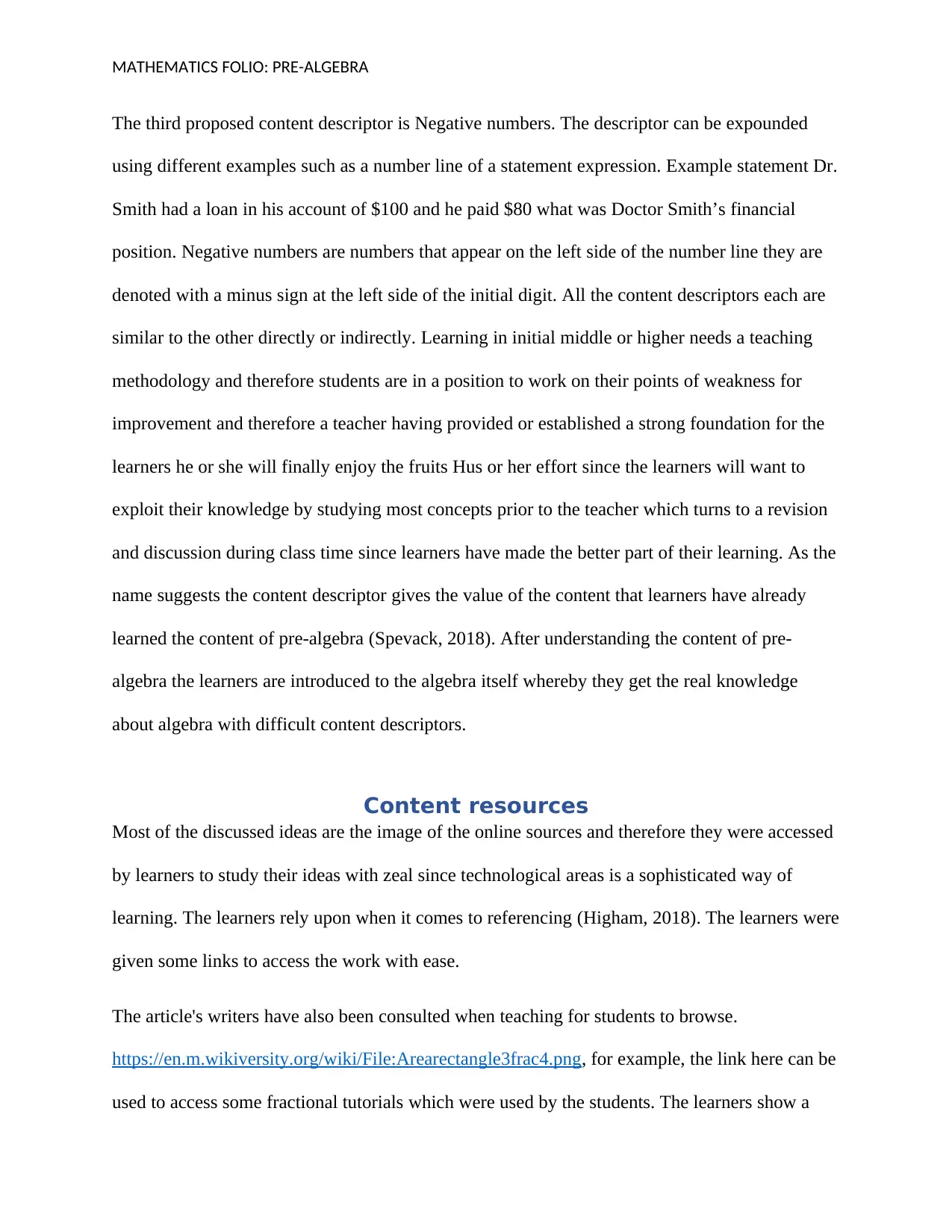
MATHEMATICS FOLIO: PRE-ALGEBRA
The third proposed content descriptor is Negative numbers. The descriptor can be expounded
using different examples such as a number line of a statement expression. Example statement Dr.
Smith had a loan in his account of $100 and he paid $80 what was Doctor Smith’s financial
position. Negative numbers are numbers that appear on the left side of the number line they are
denoted with a minus sign at the left side of the initial digit. All the content descriptors each are
similar to the other directly or indirectly. Learning in initial middle or higher needs a teaching
methodology and therefore students are in a position to work on their points of weakness for
improvement and therefore a teacher having provided or established a strong foundation for the
learners he or she will finally enjoy the fruits Hus or her effort since the learners will want to
exploit their knowledge by studying most concepts prior to the teacher which turns to a revision
and discussion during class time since learners have made the better part of their learning. As the
name suggests the content descriptor gives the value of the content that learners have already
learned the content of pre-algebra (Spevack, 2018). After understanding the content of pre-
algebra the learners are introduced to the algebra itself whereby they get the real knowledge
about algebra with difficult content descriptors.
Content resources
Most of the discussed ideas are the image of the online sources and therefore they were accessed
by learners to study their ideas with zeal since technological areas is a sophisticated way of
learning. The learners rely upon when it comes to referencing (Higham, 2018). The learners were
given some links to access the work with ease.
The article's writers have also been consulted when teaching for students to browse.
https://en.m.wikiversity.org/wiki/File:Arearectangle3frac4.png, for example, the link here can be
used to access some fractional tutorials which were used by the students. The learners show a
The third proposed content descriptor is Negative numbers. The descriptor can be expounded
using different examples such as a number line of a statement expression. Example statement Dr.
Smith had a loan in his account of $100 and he paid $80 what was Doctor Smith’s financial
position. Negative numbers are numbers that appear on the left side of the number line they are
denoted with a minus sign at the left side of the initial digit. All the content descriptors each are
similar to the other directly or indirectly. Learning in initial middle or higher needs a teaching
methodology and therefore students are in a position to work on their points of weakness for
improvement and therefore a teacher having provided or established a strong foundation for the
learners he or she will finally enjoy the fruits Hus or her effort since the learners will want to
exploit their knowledge by studying most concepts prior to the teacher which turns to a revision
and discussion during class time since learners have made the better part of their learning. As the
name suggests the content descriptor gives the value of the content that learners have already
learned the content of pre-algebra (Spevack, 2018). After understanding the content of pre-
algebra the learners are introduced to the algebra itself whereby they get the real knowledge
about algebra with difficult content descriptors.
Content resources
Most of the discussed ideas are the image of the online sources and therefore they were accessed
by learners to study their ideas with zeal since technological areas is a sophisticated way of
learning. The learners rely upon when it comes to referencing (Higham, 2018). The learners were
given some links to access the work with ease.
The article's writers have also been consulted when teaching for students to browse.
https://en.m.wikiversity.org/wiki/File:Arearectangle3frac4.png, for example, the link here can be
used to access some fractional tutorials which were used by the students. The learners show a
⊘ This is a preview!⊘
Do you want full access?
Subscribe today to unlock all pages.

Trusted by 1+ million students worldwide
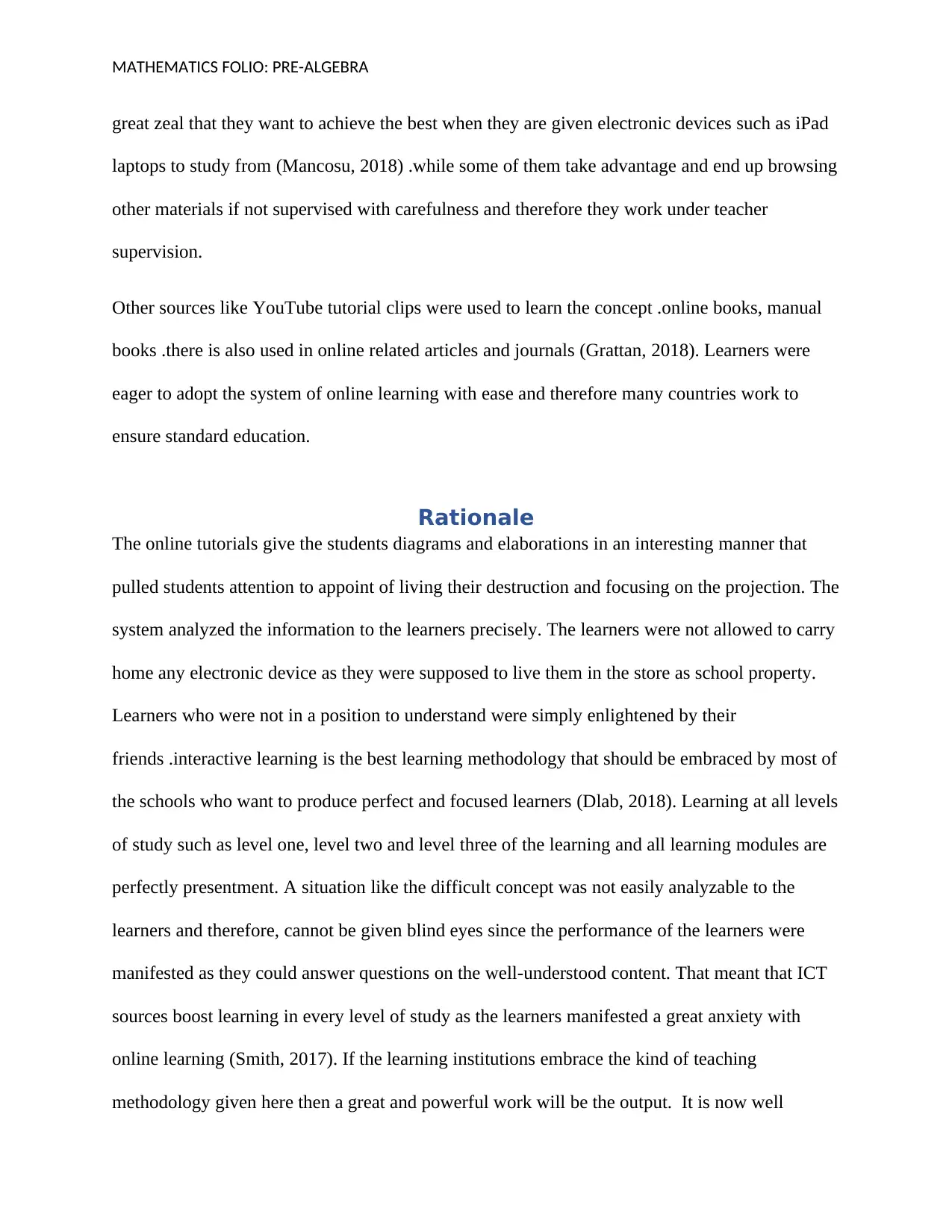
MATHEMATICS FOLIO: PRE-ALGEBRA
great zeal that they want to achieve the best when they are given electronic devices such as iPad
laptops to study from (Mancosu, 2018) .while some of them take advantage and end up browsing
other materials if not supervised with carefulness and therefore they work under teacher
supervision.
Other sources like YouTube tutorial clips were used to learn the concept .online books, manual
books .there is also used in online related articles and journals (Grattan, 2018). Learners were
eager to adopt the system of online learning with ease and therefore many countries work to
ensure standard education.
Rationale
The online tutorials give the students diagrams and elaborations in an interesting manner that
pulled students attention to appoint of living their destruction and focusing on the projection. The
system analyzed the information to the learners precisely. The learners were not allowed to carry
home any electronic device as they were supposed to live them in the store as school property.
Learners who were not in a position to understand were simply enlightened by their
friends .interactive learning is the best learning methodology that should be embraced by most of
the schools who want to produce perfect and focused learners (Dlab, 2018). Learning at all levels
of study such as level one, level two and level three of the learning and all learning modules are
perfectly presentment. A situation like the difficult concept was not easily analyzable to the
learners and therefore, cannot be given blind eyes since the performance of the learners were
manifested as they could answer questions on the well-understood content. That meant that ICT
sources boost learning in every level of study as the learners manifested a great anxiety with
online learning (Smith, 2017). If the learning institutions embrace the kind of teaching
methodology given here then a great and powerful work will be the output. It is now well
great zeal that they want to achieve the best when they are given electronic devices such as iPad
laptops to study from (Mancosu, 2018) .while some of them take advantage and end up browsing
other materials if not supervised with carefulness and therefore they work under teacher
supervision.
Other sources like YouTube tutorial clips were used to learn the concept .online books, manual
books .there is also used in online related articles and journals (Grattan, 2018). Learners were
eager to adopt the system of online learning with ease and therefore many countries work to
ensure standard education.
Rationale
The online tutorials give the students diagrams and elaborations in an interesting manner that
pulled students attention to appoint of living their destruction and focusing on the projection. The
system analyzed the information to the learners precisely. The learners were not allowed to carry
home any electronic device as they were supposed to live them in the store as school property.
Learners who were not in a position to understand were simply enlightened by their
friends .interactive learning is the best learning methodology that should be embraced by most of
the schools who want to produce perfect and focused learners (Dlab, 2018). Learning at all levels
of study such as level one, level two and level three of the learning and all learning modules are
perfectly presentment. A situation like the difficult concept was not easily analyzable to the
learners and therefore, cannot be given blind eyes since the performance of the learners were
manifested as they could answer questions on the well-understood content. That meant that ICT
sources boost learning in every level of study as the learners manifested a great anxiety with
online learning (Smith, 2017). If the learning institutions embrace the kind of teaching
methodology given here then a great and powerful work will be the output. It is now well
Paraphrase This Document
Need a fresh take? Get an instant paraphrase of this document with our AI Paraphraser
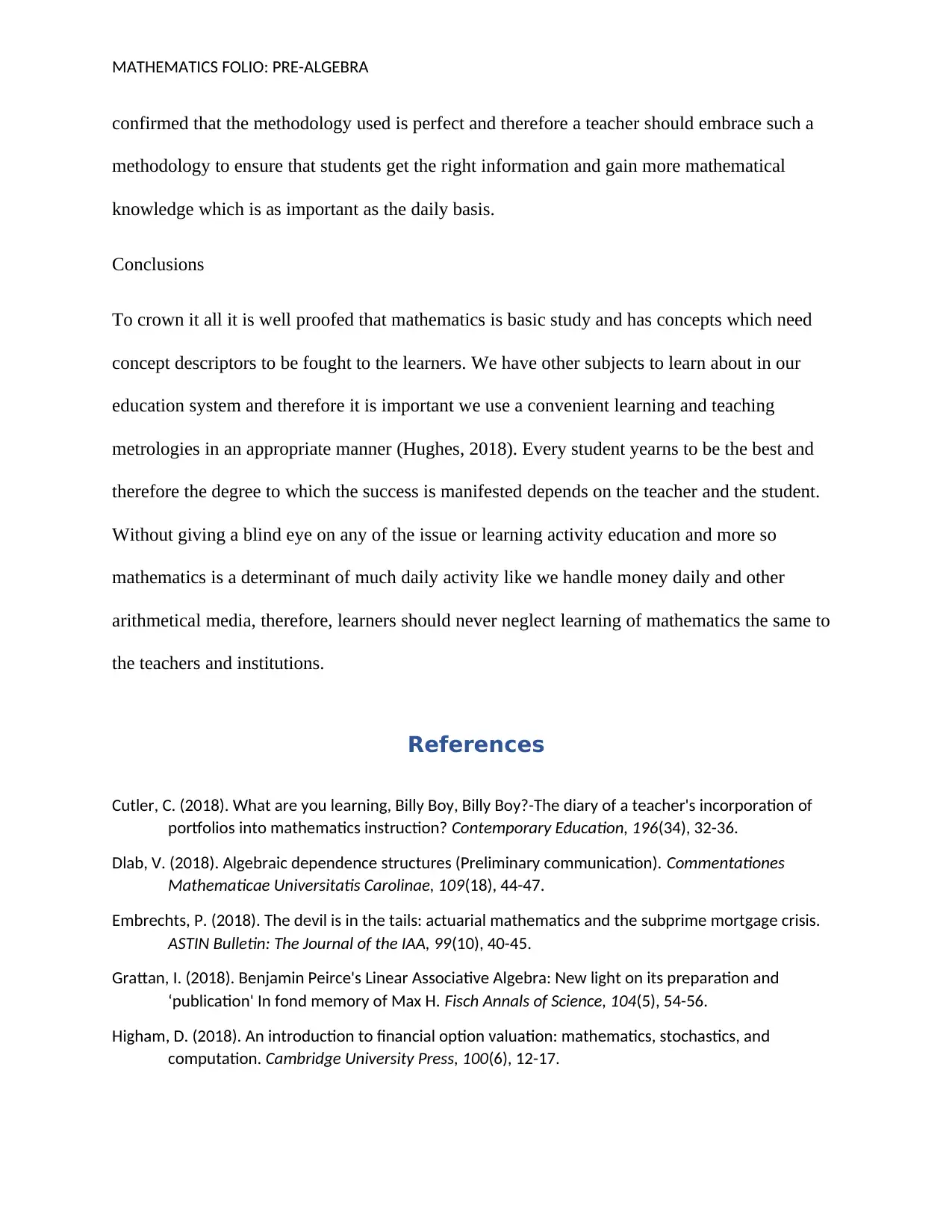
MATHEMATICS FOLIO: PRE-ALGEBRA
confirmed that the methodology used is perfect and therefore a teacher should embrace such a
methodology to ensure that students get the right information and gain more mathematical
knowledge which is as important as the daily basis.
Conclusions
To crown it all it is well proofed that mathematics is basic study and has concepts which need
concept descriptors to be fought to the learners. We have other subjects to learn about in our
education system and therefore it is important we use a convenient learning and teaching
metrologies in an appropriate manner (Hughes, 2018). Every student yearns to be the best and
therefore the degree to which the success is manifested depends on the teacher and the student.
Without giving a blind eye on any of the issue or learning activity education and more so
mathematics is a determinant of much daily activity like we handle money daily and other
arithmetical media, therefore, learners should never neglect learning of mathematics the same to
the teachers and institutions.
References
Cutler, C. (2018). What are you learning, Billy Boy, Billy Boy?-The diary of a teacher's incorporation of
portfolios into mathematics instruction? Contemporary Education, 196(34), 32-36.
Dlab, V. (2018). Algebraic dependence structures (Preliminary communication). Commentationes
Mathematicae Universitatis Carolinae, 109(18), 44-47.
Embrechts, P. (2018). The devil is in the tails: actuarial mathematics and the subprime mortgage crisis.
ASTIN Bulletin: The Journal of the IAA, 99(10), 40-45.
Grattan, I. (2018). Benjamin Peirce's Linear Associative Algebra: New light on its preparation and
‘publication' In fond memory of Max H. Fisch Annals of Science, 104(5), 54-56.
Higham, D. (2018). An introduction to financial option valuation: mathematics, stochastics, and
computation. Cambridge University Press, 100(6), 12-17.
confirmed that the methodology used is perfect and therefore a teacher should embrace such a
methodology to ensure that students get the right information and gain more mathematical
knowledge which is as important as the daily basis.
Conclusions
To crown it all it is well proofed that mathematics is basic study and has concepts which need
concept descriptors to be fought to the learners. We have other subjects to learn about in our
education system and therefore it is important we use a convenient learning and teaching
metrologies in an appropriate manner (Hughes, 2018). Every student yearns to be the best and
therefore the degree to which the success is manifested depends on the teacher and the student.
Without giving a blind eye on any of the issue or learning activity education and more so
mathematics is a determinant of much daily activity like we handle money daily and other
arithmetical media, therefore, learners should never neglect learning of mathematics the same to
the teachers and institutions.
References
Cutler, C. (2018). What are you learning, Billy Boy, Billy Boy?-The diary of a teacher's incorporation of
portfolios into mathematics instruction? Contemporary Education, 196(34), 32-36.
Dlab, V. (2018). Algebraic dependence structures (Preliminary communication). Commentationes
Mathematicae Universitatis Carolinae, 109(18), 44-47.
Embrechts, P. (2018). The devil is in the tails: actuarial mathematics and the subprime mortgage crisis.
ASTIN Bulletin: The Journal of the IAA, 99(10), 40-45.
Grattan, I. (2018). Benjamin Peirce's Linear Associative Algebra: New light on its preparation and
‘publication' In fond memory of Max H. Fisch Annals of Science, 104(5), 54-56.
Higham, D. (2018). An introduction to financial option valuation: mathematics, stochastics, and
computation. Cambridge University Press, 100(6), 12-17.
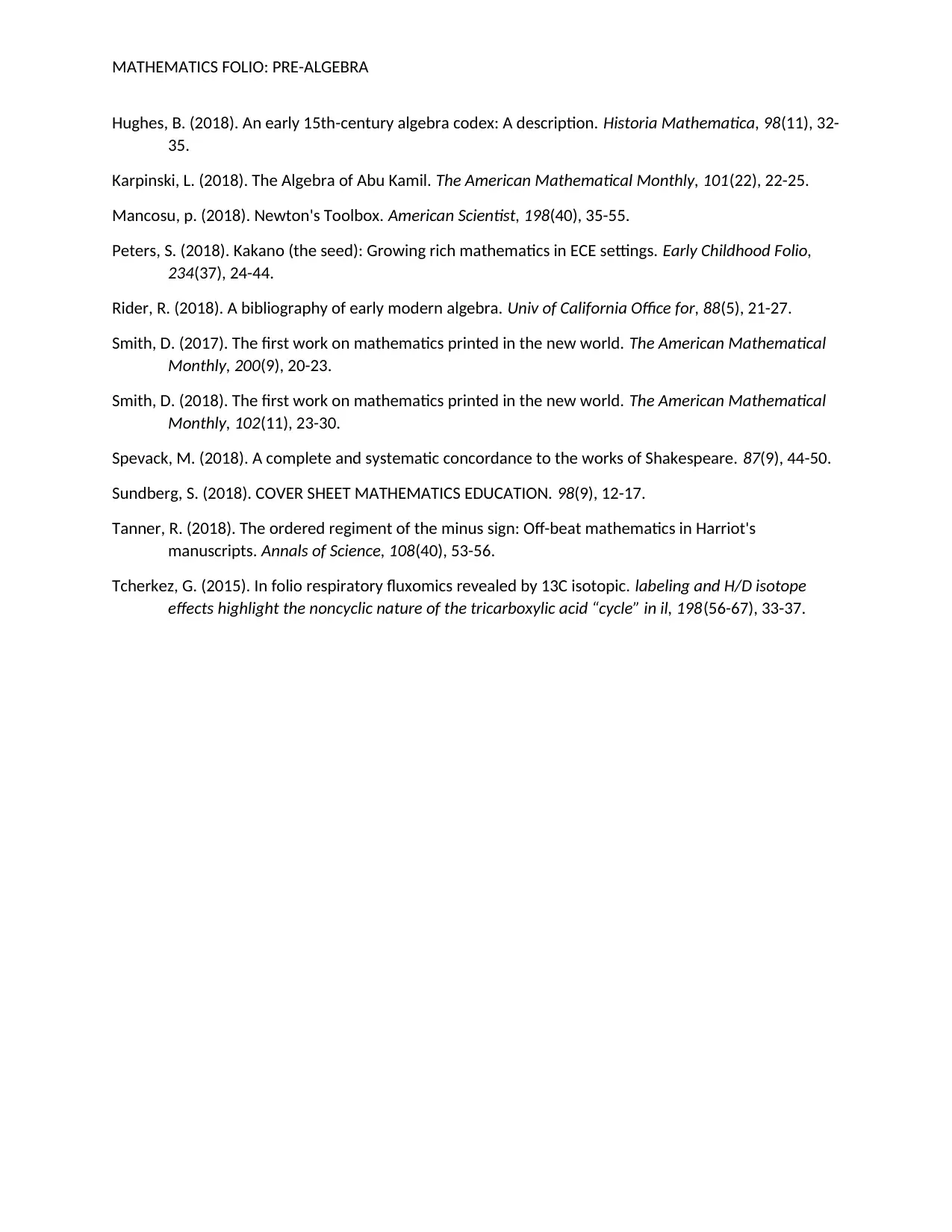
MATHEMATICS FOLIO: PRE-ALGEBRA
Hughes, B. (2018). An early 15th-century algebra codex: A description. Historia Mathematica, 98(11), 32-
35.
Karpinski, L. (2018). The Algebra of Abu Kamil. The American Mathematical Monthly, 101(22), 22-25.
Mancosu, p. (2018). Newton's Toolbox. American Scientist, 198(40), 35-55.
Peters, S. (2018). Kakano (the seed): Growing rich mathematics in ECE settings. Early Childhood Folio,
234(37), 24-44.
Rider, R. (2018). A bibliography of early modern algebra. Univ of California Office for, 88(5), 21-27.
Smith, D. (2017). The first work on mathematics printed in the new world. The American Mathematical
Monthly, 200(9), 20-23.
Smith, D. (2018). The first work on mathematics printed in the new world. The American Mathematical
Monthly, 102(11), 23-30.
Spevack, M. (2018). A complete and systematic concordance to the works of Shakespeare. 87(9), 44-50.
Sundberg, S. (2018). COVER SHEET MATHEMATICS EDUCATION. 98(9), 12-17.
Tanner, R. (2018). The ordered regiment of the minus sign: Off-beat mathematics in Harriot's
manuscripts. Annals of Science, 108(40), 53-56.
Tcherkez, G. (2015). In folio respiratory fluxomics revealed by 13C isotopic. labeling and H/D isotope
effects highlight the noncyclic nature of the tricarboxylic acid “cycle” in il, 198(56-67), 33-37.
Hughes, B. (2018). An early 15th-century algebra codex: A description. Historia Mathematica, 98(11), 32-
35.
Karpinski, L. (2018). The Algebra of Abu Kamil. The American Mathematical Monthly, 101(22), 22-25.
Mancosu, p. (2018). Newton's Toolbox. American Scientist, 198(40), 35-55.
Peters, S. (2018). Kakano (the seed): Growing rich mathematics in ECE settings. Early Childhood Folio,
234(37), 24-44.
Rider, R. (2018). A bibliography of early modern algebra. Univ of California Office for, 88(5), 21-27.
Smith, D. (2017). The first work on mathematics printed in the new world. The American Mathematical
Monthly, 200(9), 20-23.
Smith, D. (2018). The first work on mathematics printed in the new world. The American Mathematical
Monthly, 102(11), 23-30.
Spevack, M. (2018). A complete and systematic concordance to the works of Shakespeare. 87(9), 44-50.
Sundberg, S. (2018). COVER SHEET MATHEMATICS EDUCATION. 98(9), 12-17.
Tanner, R. (2018). The ordered regiment of the minus sign: Off-beat mathematics in Harriot's
manuscripts. Annals of Science, 108(40), 53-56.
Tcherkez, G. (2015). In folio respiratory fluxomics revealed by 13C isotopic. labeling and H/D isotope
effects highlight the noncyclic nature of the tricarboxylic acid “cycle” in il, 198(56-67), 33-37.
⊘ This is a preview!⊘
Do you want full access?
Subscribe today to unlock all pages.

Trusted by 1+ million students worldwide
1 out of 9
Related Documents
Your All-in-One AI-Powered Toolkit for Academic Success.
+13062052269
info@desklib.com
Available 24*7 on WhatsApp / Email
![[object Object]](/_next/static/media/star-bottom.7253800d.svg)
Unlock your academic potential
Copyright © 2020–2025 A2Z Services. All Rights Reserved. Developed and managed by ZUCOL.





